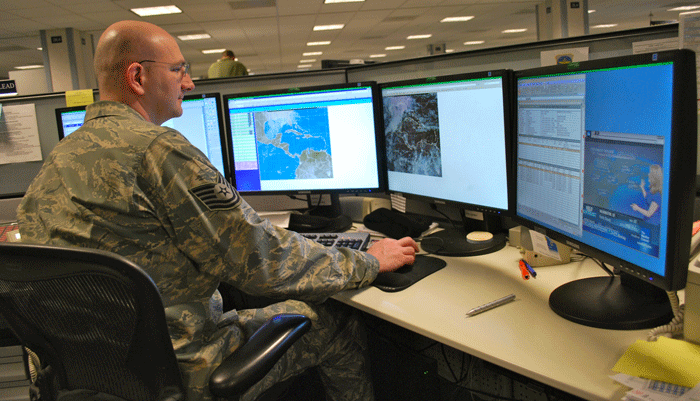05/27/2011 – First Lieutenant Adam Bennett led the discussion at the Tanker Airlift Control Center (TACC) of how weather planning figures into both the planning and execution of the TACC missions.

Working the Weather Issues in the TACC Command Center
Credit: TACC
SLD: What do the weather planners do on the TACC team?
Bennett: We ensure seasonal weather threats are taken into account during the planning stages of a mission. For example, tanker planners will come to us and say they are considering looking into changing where tankers are stationed. We’ll, take that information and build a climatology brief for them highlighting seasonal weather impacts (thunderstorms, ceiling/visibility restrictions, wind gusts, and temperature) at each airfield they are considering.
SLD: A cycle manager, basically.
Bennett: Yes. On the operations side, we continuously monitor the current weather and forecast up to 48 hours in advance. We’ll take the forecast and issue weather threats that may impact TACC missions, and we’ll work with the flight managers to mitigate these threats. For example, if for some reason an airfield’s ceiling and visibility conditions go below their prescribed minimums; a volcano erupts; or there is a hurricane out in the Atlantic; we’ll work with the flight managers on the floor and the execution people to tailor the mission around the threat and make sure the delay is minimal.
My job in TACC is to take the weather information from both the operations and planning sides and present it to the General Officers during their daily operations briefing. I advise the General Officers of what the current weather threats are and what we are doing to mitigate those threats. For example, I’ll brief them about a dust storm affecting operations in Iraq, and advise them of what mitigation efforts are being conducted.
SLD: You’re taking the daily operations plan and you’re saying “nice plan, but here’s the weather forecast I’m putting up against your plan”?
Bennett: That’s correct. Yes. As weather forecasters, we can’t vector their plan; that is reserved for the Air Traffic Controllers. But, we can advise them on a better route.
And where we sit on the floor is very crucial for operations. We sit right next to the flight managers, so we can easily communicate the weather threats to them. We’re also sitting right next to aeromedical evacuation folks. If they have something that pops up, they can quickly ask us for weather information and we can advise them on current weather threats. We are also centrally located for the planners.
SLD: What are the biggest challenges to getting it right, from your point of view?
Bennett: I think the biggest challenge that we have is staying horizontally consistent. We’re not the ones actually writing a forecast for every single location across the globe. That would take hundreds of forecasters. What we do is to take forecasts from other Air Force units and modify them to make them relevant to TACC missions.
The challenge is the collaboration process and coming up with a forecast that multiple forecasters can agree on. The goal is to provide a single accurate forecast rather than multiple, slightly different ones.


